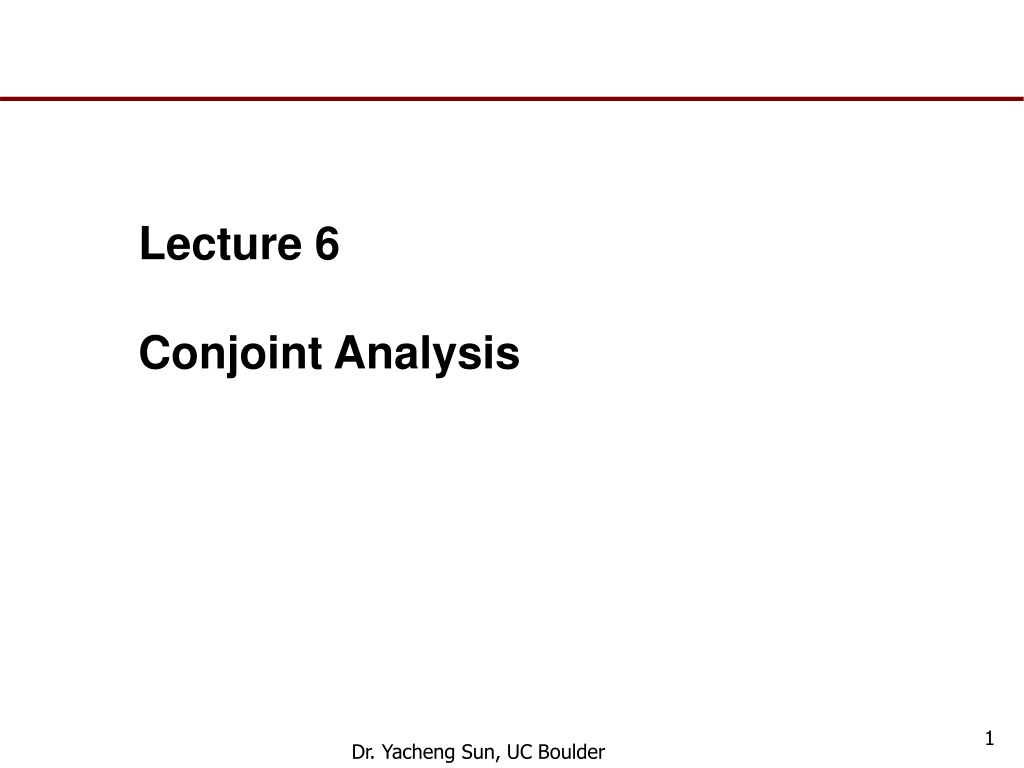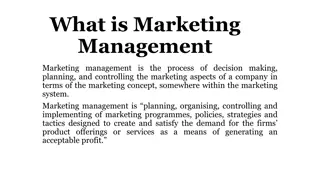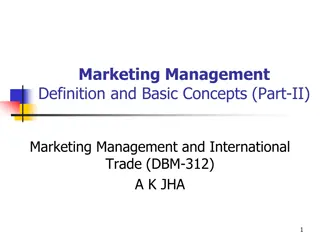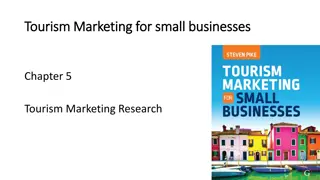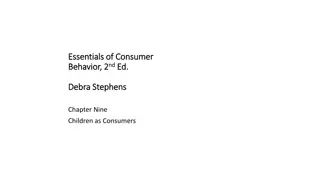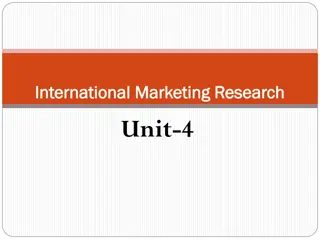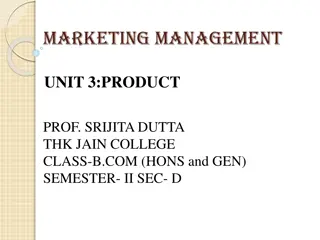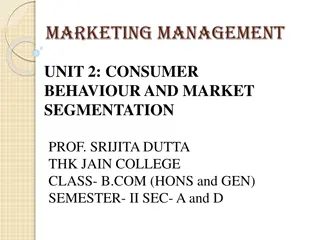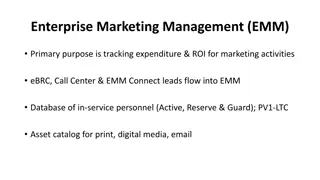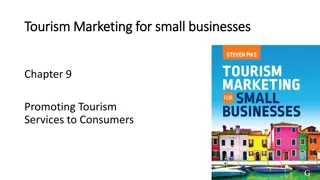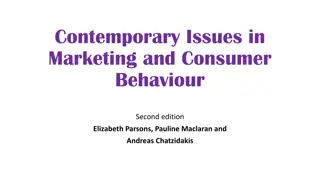Understanding Conjoint Analysis in Marketing Research
Conjoint analysis is a research technique developed in the early 1970s that helps identify how buyers value various components of a product or service bundle. By assessing buyer preferences, marketers can design offerings that maximize profitability by aligning with consumer preferences while balancing costs and value. This analysis involves considering features jointly, breaking down buyer perspectives, and addressing the demand side of the equation to create products that meet consumer needs effectively.
Download Presentation

Please find below an Image/Link to download the presentation.
The content on the website is provided AS IS for your information and personal use only. It may not be sold, licensed, or shared on other websites without obtaining consent from the author. Download presentation by click this link. If you encounter any issues during the download, it is possible that the publisher has removed the file from their server.
E N D
Presentation Transcript
Lecture 6 Conjoint Analysis 1 Dr. Yacheng Sun, UC Boulder
What is Conjoint Analysis? Research technique developed in early 70s Dictionary definition-- Conjoint: Joined together, combined. Marketer s catch-phrase-- Features CONsidered JOINTly 2 Dr. Yacheng Sun, UC Boulder
Demand Side of Equation Typical market research role is to focus first on demand side of the equation After figuring out what buyers want, next assess whether it can be built/provided in a cost- effective manner Measures how buyers value components of a product/service bundle 3 Dr. Yacheng Sun, UC Boulder
Different Perspectives, Different Goals Buyers want all of the most desirable features at lowest possible price Sellers want to maximize profits by: 1) minimizing costs of providing features 2) providing products that offer greater overall value than the competition 4 Dr. Yacheng Sun, UC Boulder
A simple example We want to market a new golf ball. There are three important product features. Average Driving Distance Average Ball Life Price 5 Dr. Yacheng Sun, UC Boulder
Example: Golf Ball Average Driving Distance 275 yards 250 yards 225 yards Average Ball Life Price 54 holes 36 holes 18 holes $1.25 $1.50 $1.75 6 Dr. Yacheng Sun, UC Boulder
Obviously, the ideal ball from consumers view is: Average Driving Distance: 275 yards Average Ball Life: 54 holes Price: $1.25 The ideal ball from manufacturers view is: Average Driving Distance: 225 yards Average Ball Life: 18 holes Price: $1.75 Lose money selling the first, but consumers won t be happy with the second option. 7 Dr. Yacheng Sun, UC Boulder
Breaking the Problem Down If we learn how buyers value the components of a product, we are in a better position to design those that improve profitability 8 Dr. Yacheng Sun, UC Boulder
How to Learn What Customers Want? Ask Direct Questions about preference: What brand do you prefer? What Interest Rate would you like? What Annual Fee would you like? What Credit Limit would you like? Answers often trivial and unenlightening (e.g. respondents prefer low fees to high fees, higher credit limits to low credit limits) 9 Dr. Yacheng Sun, UC Boulder
How to Learn What Is Important? Ask Direct Questions about importances How important is it that you get the <<brand, interest rate, annual fee, credit limit>> that you want? 10 Dr. Yacheng Sun, UC Boulder
Stated Importances Importance Ratings often have low discrimination: Average Importance Ratings 6.7 Brand 7.2 Interest Rate 8.1 Annual Fee 7.5 Credit Limit 0 5 10 11 Dr. Yacheng Sun, UC Boulder
Stated Importances Answers often have ______________, with most answers falling in very important categories Answers sometimes useful for segmenting market, but still not as actionable as could be 12 Dr. Yacheng Sun, UC Boulder
Self-Explicated, Multi-Attribute Models Self-explicated models use a combination of the Which brands do you prefer? and How important is brand? questions For each attribute (brand, price, performance, etc.) respondents rate or rank the levels within that attribute Respondents rate an overall importance for the attribute, when considering the various levels involved Preference scores (utilities) can be developed by combining the preferences for levels with the importance of the attribute overall 13 Dr. Yacheng Sun, UC Boulder
Self-Explicated Models (continued) Self-explicated models can be used to study many attributes and levels in a questionnaire Some researchers refer to self-explicated models as self- explicated conjoint, but this is a ________ as no ________________ are involved In certain cases, self-explicated models perform as well as conjoint analysis Most researchers favor conjoint analysis or discrete choice modeling, when the project allows 14 Dr. Yacheng Sun, UC Boulder
Conjoint Analysis 15 Dr. Yacheng Sun, UC Boulder
How Does Conjoint Analysis Work? Vary the product features (independent variables) to build many (usually 12 or more) product concepts Ask respondents to rate/rank those product concepts (dependent variable) Based on the respondents evaluations of the product concepts, figure out how much unique value (utility) each of the features added (Regress dependent variable on independent variables; betas equal part worth utilities.) 16 Dr. Yacheng Sun, UC Boulder
Whats So Good about Conjoint? More realistic questions: Would you prefer . . . 210 Horsepower or 140 Horsepower 17 MPG 28 MPG If choose left, you prefer Power. If choose right, you prefer Fuel Economy Rather than ask directly whether you prefer Power over Fuel Economy, we present realistic tradeoff scenarios and infer preferences from your product choices 17 Dr. Yacheng Sun, UC Boulder
Whats So Good about Conjoint? (cont) When respondents are forced to make difficult tradeoffs, we learn what they truly value 18 Dr. Yacheng Sun, UC Boulder Dr. Yacheng Sun, UC Boulder
Conjoint Study Process Stage 1 Designing the conjoint study: Step 1.1: service category, Step 1.2: Step 1.3: Select attributes relevant to the product or Select levels for each attribute, and Develop the product bundles to be evaluated. Stage 2 Obtaining data from a sample of respondents: Step 2.1: Design a data-collection procedure, and Step 2.2: Select a computation method for obtaining part-worth functions. Stage 3 Evaluating product design options: Step 3.1: worth functions, Step 3.2: Step 3.3: Segment customers based on their part- Design market simulations, and Select choice rule. ME Conjoint Analysis 2006 19 - 19
State 1 Design the Conjoint Study 20 Dr. Yacheng Sun, UC Boulder
Attributes assumed to be independent (Brand, Speed, Color, Price, etc.) Each attribute has varying degrees, or levels Brand: Coke, Pepsi, Sprite Speed: 5 pages per minute, 10 pages per minute Color: Red, Blue, Green, Black Each level is assumed to be ________________ of the others (a product has one and only one level of that attribute) 21 Dr. Yacheng Sun, UC Boulder
Rules for Formulating Attribute Levels Levels are assumed to be mutually exclusive Attribute: Add-on features level 1: Sunroof level 2: GPS System level 3: Video Screen If define levels in this way, you cannot determine the value of providing two or three of these features at the same time 22 Dr. Yacheng Sun, UC Boulder
Rules for Formulating Attribute Levels Levels should have ________________ meaning Very expensive vs. Costs $575 Weight: 5 to 7 kilos vs. Weight 6 kilos One description leaves meaning up to individual interpretation, while the other does not 23 Dr. Yacheng Sun, UC Boulder
Rules for Formulating Attribute Levels Don t include too many levels for any one attribute The usual number is about 3 to 5 levels per attribute The temptation (for example) is to include many, many levels of price, so we can estimate people s preferences for each But, you spread your precious observations across more parameters to be estimated, resulting in noisier (less precise) measurement of ALL price levels Also, needs to beware of ________________ 24 Dr. Yacheng Sun, UC Boulder
Designing a Frozen Pizza Attributes Type of crust (3 types) Topping (4 varieties) Amount of cheese (2 levels) Type of cheese (3 types) Price (3 levels) Crust Type of cheese Topping Pineapple Veggie Sausage Pepperoni Romano Mixed cheese Mozzeralla Pan Thin Thick Price Amount of cheese $9.99 $8.99 $7.99 2 Oz. 6 Oz. Note: The example in the book also has a 4 oz option for amount of cheese. A total of 216 (3x4x3x2x3) different pizzas can be developed from these options! Dr. Yacheng Sun, UC Boulder 25
State 2 Obtain Data from A Sample of Respondents 26 Dr. Yacheng Sun, UC Boulder
Methods of Obtaining Data from respondents Pair-wise evaluation Rank-ordering product bundles Evaluating products on a rating scale 27 Dr. Yacheng Sun, UC Boulder
Example: Design Frozen Pizza Product Option 1 2 3 4 5 6 7 8 Cuisine Distance Price Range Preference Rank Value Italian Italian Italian Italian Thai Thai Thai Thai Near Near Far Far Near Near Far Far $10 $15 $10 $15 $10 $15 $10 $15 28 Dr. Yacheng Sun, UC Boulder
Preference Data for Frozen Pizzas Product Option Cuisine Distance Price Range Preference Rank Value 8 6 4 2 7 5 3 1 1 2 3 4 5 6 7 8 Italian Italian Italian Italian Thai Thai Thai Thai Near Near Far Far Near Near Far Far $10 $15 $10 $15 $10 $15 $10 $15 29 Dr. Yacheng Sun, UC Boulder
Designing a Frozen Pizza Example Ratings Data 30 Dr. Yacheng Sun, UC Boulder
State 3 Evaluate Product Design Options 31 Dr. Yacheng Sun, UC Boulder
Conjoint Utility Computations k m j U(P) = aijxij j=1 i=1 P: A particular product/concept of interest U(P): The utility associated with product P aij: Utility associated with the jth level (j = 1, 2, 3...kj) on the ith attribute kj: Number of levels of attribute i m: Number of attributes xij: 1 if the jth level of the ith attribute is present in product P, 0 otherwise 32 Dr. Yacheng Sun, UC Boulder
Utility Computation (Designing a Frozen Pizza) Customer s Utility Cust 1 0 10 15 10 25 30 3 10 10 20 35 Cust 2 45 -5 10 0 5 20 -10 10 15 -10 -5 Cust 3 30 0 0 50 0 0 0 -5 -20 10 20 Base* Thin crust Thick crust Veggie Sausage Pepperoni Mixed Cheese Mozzarella 6 oz $ 8.99 $ 7.99 33 Dr. Yacheng Sun, UC Boulder
Market Share and Revenue Share Forecasts Define the competitive set this is the set of products from which customers in the target segment make their choices. Some of them may be existing products and, others concepts being evaluated. We denote this set of products as P1, P2,...PN. Select Choice rule Maximum utility rule Share of preference rule Logit choice rule 34 Dr. Yacheng Sun, UC Boulder
Maximum Utility Rule (Example) Under this choice rule, each customer selects the product that offers him/her the highest utility among the competing alternatives. Market share for product Pi is then given by: Consumers who prefer i the most K K ) = = MS P ( i = =1 k K is the number of consumers who participated in the study. 35 Dr. Yacheng Sun, UC Boulder
Other Choice Rules Share of utility rule: Under this choice rule, the consumer selects each product with a probability that is proportional to ________________ compared to ____________________ derived from all the products in the choice set. Logit choice rule: This is similar to the share of utility rule, except that it gives larger weights to more preferred alternatives and smaller weights to less preferred alternatives. 36 Dr. Yacheng Sun, UC Boulder
Market Share Computation (Designing a Frozen Pizza) Consider a market with three customers and three products: Crust Topping Type of Cheese Amount of Cheese Price Aloha Special Pan Pineapple Mozzarella 6 oz $8.99 Meat-Lover s Treat Thick Pepperoni Mixed Cheese 6 oz $9.99 Veggie Delite Thin Veggie Romano 2 oz $7.99 37 Dr. Yacheng Sun, UC Boulder
Market Share Computation (Designing a Frozen Pizza) Utility (Value) of each product for each customer. Customer 1 Customer 2 Customer 3 Aloha Special Meat-Lover s Treat 58 50 10 Veggie DeLite 40 45 30 55 35 100 Maximum Utility Rule: If we assume customers will only buy the product with the highest utility, the market share for Meat Lover s treat is 2/3 and for Veggie Delite is 1/3. Share of preference rule: If we assume that each customer will buy each product in proportion to its utility relative to the other products, then market shares for the three products are: Aloha Special (27.2%), Meat Lover s Treat (27.9%) and Veggie Delite (44.9%). 38 Dr. Yacheng Sun, UC Boulder
Identifying Segments Based on Conjoint Part Worths 39 Dr. Yacheng Sun, UC Boulder
Product Design for Specific Segments Design optimal product by segment Segment 1 (Value segment 52% of the market): A thick-crust pizza with 6 Oz mixed cheese and pineapple (or sausage) topping priced at $7.99. This will get about 32% share and revenue index of around 100 (the same as the base product). Segment 3 (Premium segment -- 27.5% of the market): A pan pizza with 2 Oz of Romano cheese and pepperoni or sausage topping priced at $9.99. This will get 31% share of this segment and have revenue index of about 100. 40 Dr. Yacheng Sun, UC Boulder
Next class: Price Levels and Policies Dr. Yacheng Sun, UC Boulder
